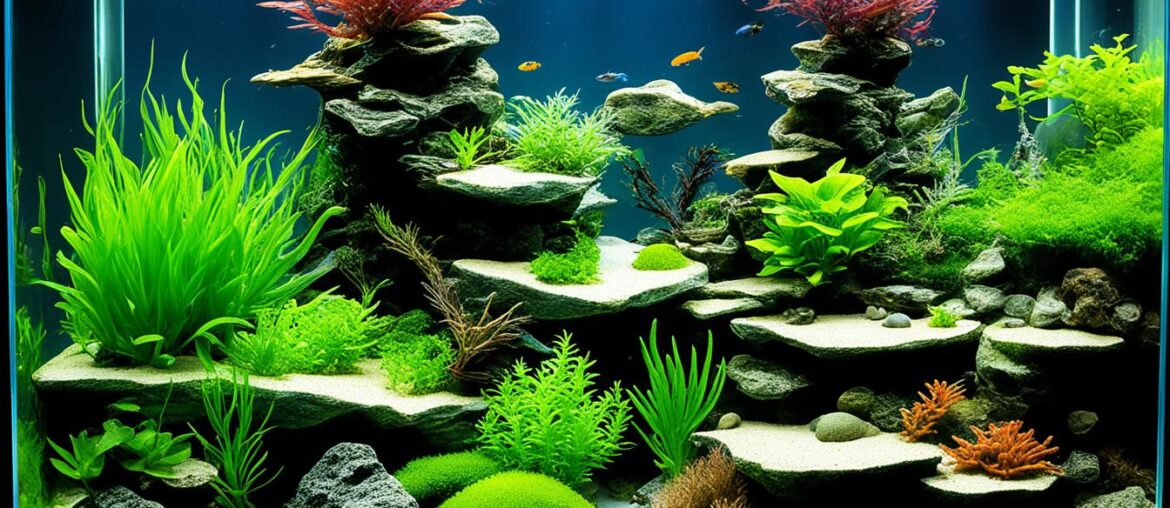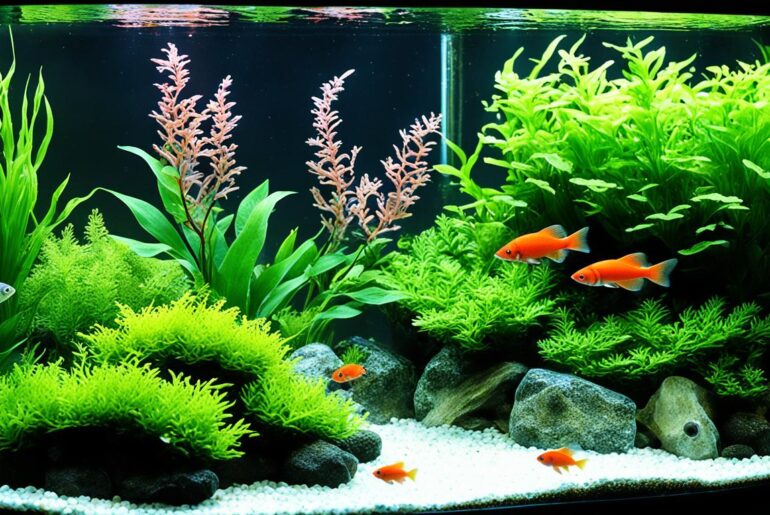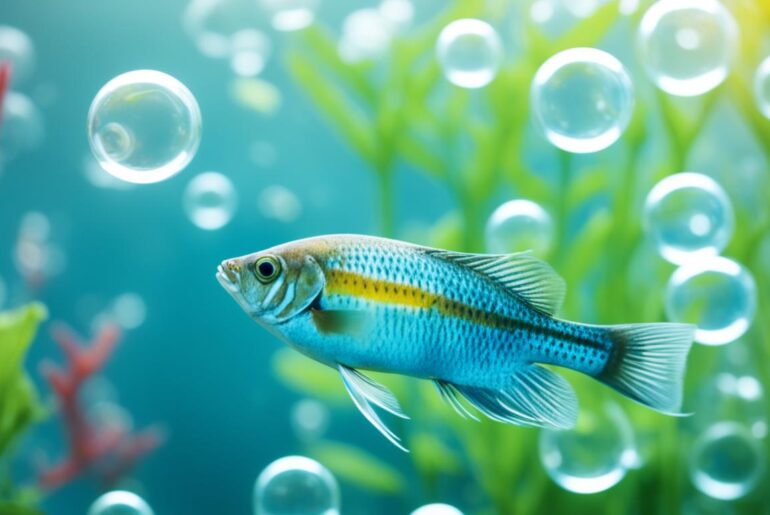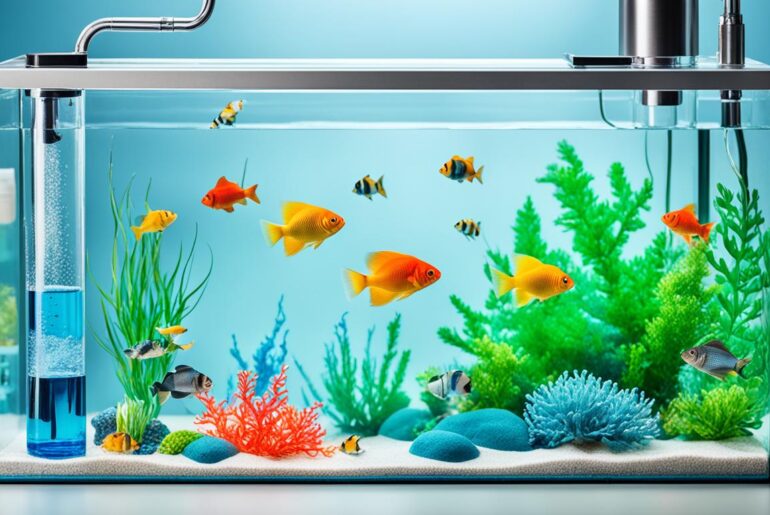As an aquarium enthusiast, I know the joy and excitement that comes with setting up a new tank. The anticipation of filling it with vibrant fish and creating a beautiful underwater ecosystem is truly special. But I also know the importance of properly cycling the aquarium to ensure the health and well-being of our aquatic friends.
Over the years, I have learned the ins and outs of aquarium cycling through my own experiences and extensive research. I have seen the impact it can have on the overall success and longevity of a freshwater aquarium. That is why I am excited to share with you these 10 steps to efficiently cycle your large freshwater aquarium.
Whether you’re a beginner or an experienced aquarist, these steps will guide you through the essential process of establishing beneficial bacteria, maintaining optimal aquarium water parameters, and ensuring effective biofiltration. By following these steps, you’ll create a safe and healthy environment for your fish to thrive in.
Key Takeaways:
- Efficiently cycling your large freshwater aquarium is essential for the health and well-being of your fish.
- Proper aquarium cycling involves establishing beneficial bacteria, maintaining optimal water parameters, and ensuring effective biofiltration.
- By following the 10 steps outlined in this guide, you can successfully cycle your aquarium and create a thriving underwater ecosystem.
- Regular monitoring of ammonia and nitrite levels during the cycling process is crucial for the well-being of your fish.
- Introduce fish gradually to the aquarium once the cycling process is complete to ensure a smooth transition and minimize stress.
What is Aquarium Cycling?
When setting up a new aquarium, one essential process you need to understand is aquarium cycling. This crucial step involves creating a biologically safe environment for your fish, ensuring their health and well-being. So, what exactly is aquarium cycling?
Aquarium cycling is the process of establishing a balanced nitrogen cycle in your tank. It involves introducing nitrifying bacteria that play a vital role in converting harmful ammonia into less toxic compounds. Let’s explore the key elements of aquarium cycling:
- Nitrogen Cycle: The nitrogen cycle refers to the natural process by which organic waste in the aquarium gets broken down and converted into less harmful substances. This cycle consists of several stages, including the conversion of ammonia to nitrite and further to nitrate.
- Nitrifying Bacteria: Nitrifying bacteria are beneficial microorganisms that colonize the surfaces of your aquarium, especially the filter media. These bacteria convert toxic ammonia to nitrite and, eventually, to nitrate during the nitrogen cycle.
- Ammonia Buildup: Fish produce waste in the form of ammonia, which is highly toxic to them. Without the presence of nitrifying bacteria, ammonia levels can build up rapidly, endangering the health of your fish.
- Nitrite Conversion: Nitrifying bacteria convert the toxic nitrite, which is produced as a result of ammonia breakdown, into less harmful nitrate. Nitrite can cause significant harm to fish if present in high concentrations.
- Nitrate Conversion: The final stage of the nitrogen cycle involves the conversion of nitrate. While nitrate is less toxic than ammonia and nitrite, excessive levels can still pose risks to fish health. Regular water changes are necessary to keep nitrate levels in check.
Why is Aquarium Cycling Important?
Aquarium cycling is vital for the long-term health and survival of your fish. By establishing a proper nitrogen cycle, you create a stable and balanced ecosystem in which your fish can thrive. Without cycling, ammonia and nitrite levels can become toxic, leading to fish stress, illness, and even death.
Cycling your aquarium also helps in maintaining stable water conditions. By promoting the growth of nitrifying bacteria, you ensure efficient biological filtration, which helps maintain optimal water quality. This biological filtration is essential for removing harmful substances from the water and promoting a healthy environment for your fish.
Aquarium cycling is an ongoing process, and understanding its importance will help you create a safe and thriving habitat for your aquatic pets.
Image: Aquarium cycling promotes a balanced nitrogen cycle and helps maintain a healthy environment for your fish.
Why Do Aquariums Need to be Cycled?
Aquariums need to be cycled to allow nitrifying bacteria to establish themselves in the biofilters. These bacteria play a vital role in breaking down the ammonia produced by fish waste, converting it into less harmful compounds. By cycling the aquarium, you create a biologically stable environment that can effectively handle ammonia levels.
Introducing fish too quickly or in large numbers can overwhelm the biofilters, leading to New Tank Syndrome. This condition occurs when ammonia levels spike, exposing the fish to toxic substances and compromising their health. Proper aquarium cycling reduces the risk of ammonia exposure and helps ensure the well-being of your aquatic pets.
The Role of Nitrifying Bacteria
Nitrifying bacteria are the unsung heroes of aquarium cycling. These beneficial microbes convert harmful ammonia into nitrite and then further convert nitrite into nitrate, a less harmful compound. It is through this nitrogen cycle that the toxicity of ammonia is neutralized, creating a safe environment for fish.
“During the cycling process, the nitrifying bacteria gradually establish themselves in the biofilters, growing and multiplying to handle the ammonia produced by fish waste. By providing a stable and mature biofilter, you create a sustainable nitrogen cycle that keeps the aquarium environment safe and healthy.”
Without these bacteria, ammonia levels would continually rise, posing a severe risk to fish health. By cycling the aquarium, you allow time for the nitrifying bacteria to colonize the biofilters and establish a stable population, ensuring the effective breakdown of ammonia and maintaining optimal water conditions.
Promoting Fish Health
Cycling the aquarium is essential before introducing fish. It gives the tank time to develop sufficient biological filtration to handle the waste produced by fish. Rushing the process by adding fish before the biofilters are established can lead to ammonia spikes, resulting in stress, disease, and even death of the fish.
By properly cycling the aquarium, you reduce the risk of ammonia exposure and create a healthy and stable environment for your fish. This promotes their overall well-being, allowing them to thrive and flourish in their new aquatic home.
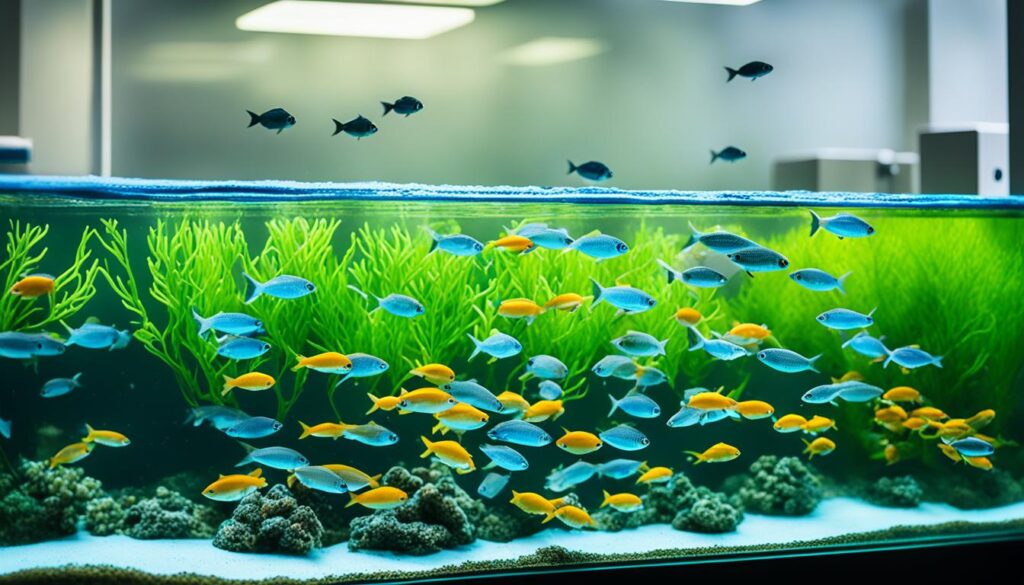
Cycling the aquarium ensures a biologically stable environment, reducing the risk of ammonia exposure and promoting fish health.
How Long Does an Aquarium Take to Cycle?
The time it takes for an aquarium to cycle can vary depending on several factors. These include tank size, water pH, and water temperature. In general, the cycling process takes between four to eight weeks.
To expedite the cycle, it’s important to closely monitor the water temperature and pH levels. Keeping them within the appropriate range will help promote the growth of beneficial bacteria. A temperature of 78-82°F (25-28°C) and a pH level between 7.0 and 8.0 are commonly recommended.
Regular testing of ammonia, nitrite, and nitrate levels is crucial throughout the cycling process. Test the water every one to two days to track the progress of the cycle. This will help ensure that the ammonia and nitrite levels reach zero and nitrates are being produced, indicating the completion of the cycle.
Proper monitoring and patience are essential in achieving a successfully cycled aquarium. It is important to note that rushing the cycle can be detrimental to the health and well-being of your fish. Take the necessary time to establish a stable nitrogen cycle before introducing fish to your aquarium.
What Do I Need to Cycle an Aquarium?
Before cycling an aquarium, you will need a few essential items to ensure a successful process. These items include:
- Fish food: A source of ammonia is necessary to kickstart the nitrogen cycle. Fish food can provide this ammonia source as it decomposes. Choose a high-quality fish food suitable for the species you plan to keep.
- Aquarium test kit: Monitoring ammonia, nitrite, and nitrate levels is crucial during the cycling process. An aquarium test kit will allow you to regularly check these parameters, ensuring a safe and healthy environment for your fish.
- Aquarium components: To set up your aquarium, you’ll need various components such as pumps, filters, and substrate. These components create a suitable habitat for beneficial bacteria that play a crucial role in the nitrogen cycle.
- Water filter: A quality water filter is essential for maintaining clean and healthy water in your aquarium. Consider using a water filter that utilizes reverse osmosis technology to eliminate contaminants like chlorine and chloramine that can interfere with the nitrogen cycle.
By having these necessary items on hand, you’ll be well-prepared to begin the aquarium cycling process and create an optimal environment for your fish.
Cycling an Aquarium Without Fish
One popular and humane method of cycling an aquarium involves the process known as fishless cycling. This approach allows for a controlled and safe environment for your fish by eliminating the risk of ammonia exposure during the cycling process. Fishless cycling involves several essential steps to establish a healthy and stable aquarium environment.
Setting Up the Aquarium Components
Prior to starting the fishless cycling process, ensure that all necessary aquarium components are properly set up and functioning. This includes filters, pumps, substrate, and biofilters. These components provide surfaces for beneficial nitrifying bacteria to accumulate and reproduce, aiding in the establishment of a robust nitrogen cycle. Keeping all essential equipment running during the cycling process promotes the growth of beneficial bacteria.
Maintaining Water pH within the Appropriate Range
The water’s pH level plays a vital role in the efficiency of the nitrogen cycle and the proper functioning of nitrifying bacteria. It is important to maintain the water’s pH within the appropriate range for the health of the bacteria and the well-being of your fish. Aim for a pH level between 7.0 and 7.8 to ensure optimal conditions for the nitrogen cycle.
Adding an Ammonia Source
Since fish are not present during fishless cycling, an ammonia source needs to be added manually to simulate the production of ammonia from fish waste. Common ammonia sources include pure ammonia solutions or fish food. Add a small amount of ammonia source to the aquarium, monitoring the ammonia levels throughout the cycling process.
Monitoring Ammonia, Nitrite, and Nitrate Levels
Regularly test and monitor the ammonia, nitrite, and nitrate levels using an aquarium test kit. This allows you to track the progress of the cycling process and ensure the appropriate balance of chemical compounds. Initially, ammonia levels will rise as nitrifying bacteria begin converting it into nitrite. Over time, nitrite will also increase before decreasing, indicating the establishment of a stable bacterial population. Once ammonia and nitrite levels reach zero and nitrates are being produced, the aquarium is ready for the next step.
Adding Fish
After completing the fishless cycling process and achieving stable water parameters, you can safely introduce fish to your aquarium. Start by adding a small number of fish and gradually increase the population over time. Monitor and maintain ammonia, nitrite, and nitrate levels regularly to ensure the continued health and well-being of your fish.
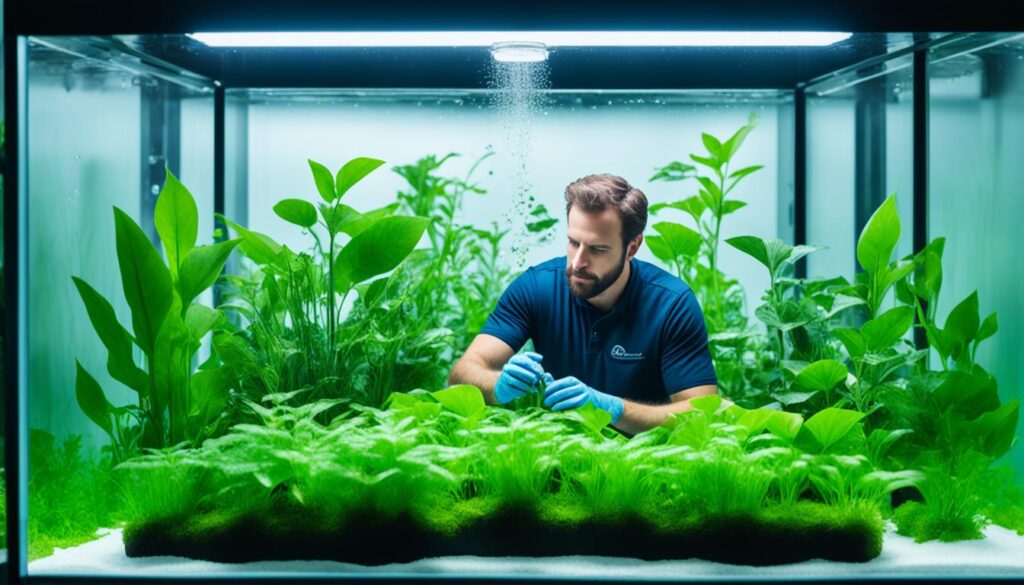
Setting Up the Tank’s Components
Before cycling the aquarium, it is important to ensure that all the necessary components are properly set up and functioning. These components include pumps, filters, substrate, and biofilters, which play vital roles in creating a healthy environment for your fish.
First, let’s talk about pumps. These devices are responsible for circulating the water in your aquarium, promoting oxygenation and preventing stagnation. Make sure your pump is correctly installed and functioning properly to maintain a well-circulated and oxygen-rich environment for your fish.
Next, let’s discuss filters. Filters help remove debris, excess waste, and harmful substances from the water in your aquarium. There are several types of filters available, including mechanical, chemical, and biological filters. The biological filter, also known as the biofilter, is especially important for establishing and maintaining the nitrogen cycle. It provides a surface area for beneficial bacteria to colonize and convert harmful ammonia and nitrite into less toxic nitrate.
Substrate is another essential component of your aquarium setup. It serves as the foundation for your decor, as well as a medium for beneficial bacteria growth. Choose a substrate that is suitable for your specific aquarium requirements and the types of fish you plan to keep.
Biofilters, as mentioned earlier, are crucial for the establishment of beneficial bacteria. These bacteria play a key role in the nitrogen cycle by breaking down harmful ammonia and nitrite. Biofilters are typically integrated into the filtration system and provide a large surface area for bacterial colonization.
To ensure the successful cycling of your aquarium, it is essential to have all of these components properly set up and functioning. By creating an environment that supports the growth of beneficial bacteria, you are laying the foundation for a healthy and thriving aquarium ecosystem.
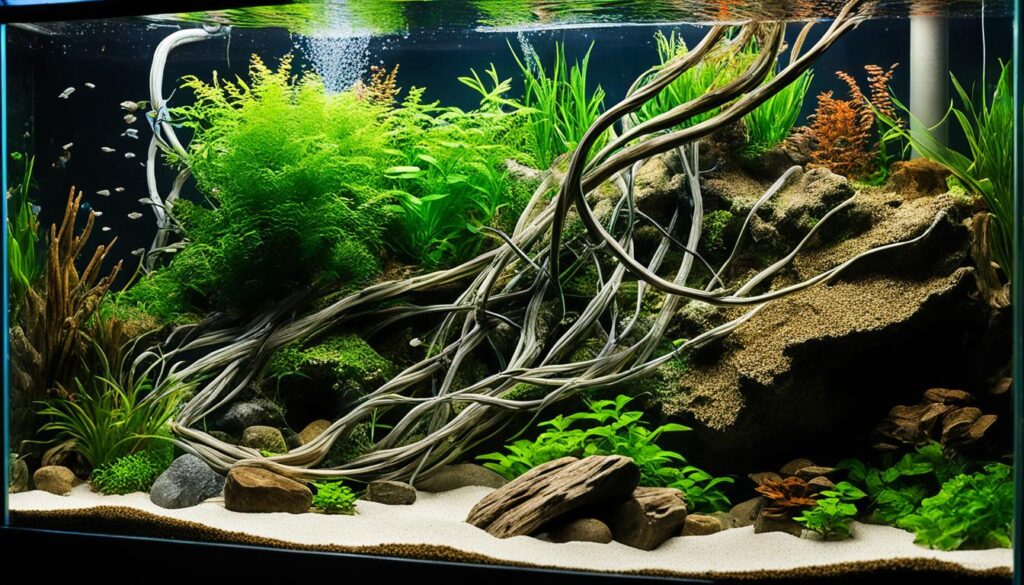
| Component | Function |
|---|---|
| Pumps | Circulate the water, promoting oxygenation |
| Filters | Remove debris and harmful substances from the water |
| Substrate | Provides a foundation for decor and beneficial bacteria growth |
| Biofilters | Facilitate the establishment of beneficial bacteria for the nitrogen cycle |
Checking the Water’s pH
Maintaining the water’s pH within the appropriate range is crucial for the efficient nitrogen cycle and regulation of ammonia levels in your freshwater aquarium. The pH level affects the overall health and well-being of your fish, so it’s important to ensure it remains within the optimal range.
The ideal pH range for the nitrogen cycle to occur efficiently and for most freshwater fish is between 7.0 and 7.8. This slightly alkaline range supports the growth of beneficial bacteria and provides a stable environment for your aquatic pets.
If the water pH becomes too acidic or too alkaline, it can disrupt the nitrogen cycle and lead to ammonia buildup. Water that is too acidic (pH below 7.0) can be harmful to fish, while water that is too alkaline (pH above 7.8) can hinder the growth of beneficial bacteria.
Regular pH Testing
To ensure the pH level remains in the appropriate range, it is recommended to regularly test the water’s pH using pH test strips or an all-in-one test kit. These testing methods provide accurate and instant results, allowing you to monitor any fluctuations in pH levels.
By regularly monitoring the water’s pH, you can take appropriate actions to maintain the ideal conditions for the nitrogen cycle and the overall health of your fish. If the pH level deviates from the optimal range, there are products available, such as pH stabilizers, that can help adjust the pH.
Remember, stability is key when it comes to pH levels. Sudden pH changes can stress or harm your fish, so it’s important to make gradual adjustments if necessary. Regular monitoring and maintenance of the water’s pH will contribute to a healthy and thriving aquarium environment.
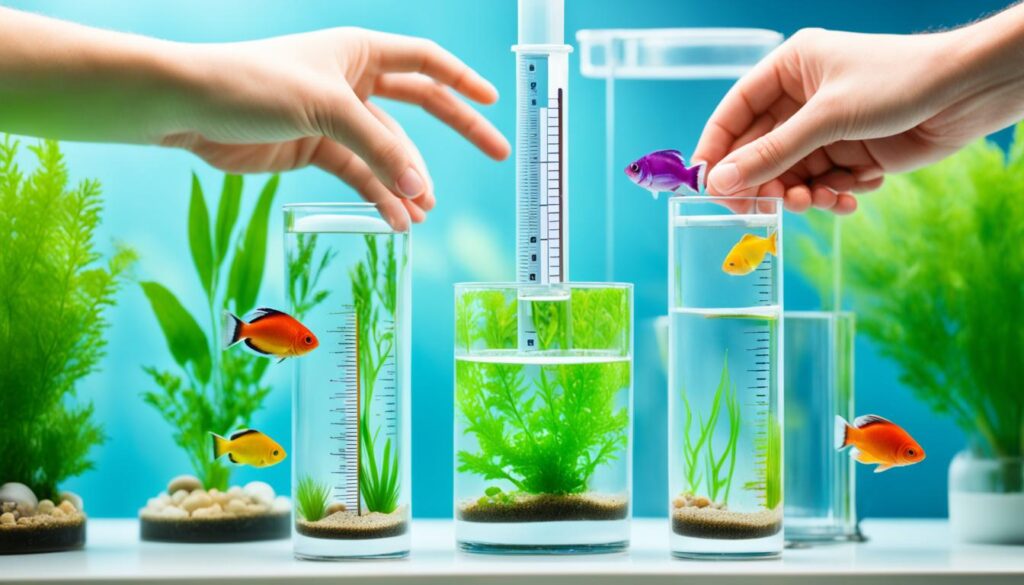
Key Takeaways:
- Maintaining the water’s pH within the optimal range of 7.0 to 7.8 is crucial for the efficient nitrogen cycle and the health of most freshwater fish.
- Fluctuations in pH outside the recommended range can disrupt the nitrogen cycle and lead to ammonia buildup.
- Regularly testing the water’s pH using pH test strips or an all-in-one test kit is essential for monitoring and maintaining optimal pH levels.
- Gradual adjustments should be made if necessary to avoid stressing or harming fish.
Adding Ammonia to the Tank
To kickstart the nitrogen cycle, an ammonia source needs to be added to the tank. One effective method is to add fish food, allowing it to decay and release ammonia into the water. The amount of fish food added should be equivalent to what would be fed to the desired number of fish in the tank. Regularly checking and maintaining ammonia levels within the appropriate range is crucial for the success of the nitrogen cycle.
Ammonia Source: Fish Food
When adding ammonia to the tank, fish food serves as a reliable source. As the fish food decays, it releases ammonia into the water, providing the necessary fuel for the growth of nitrifying bacteria.
| Ammonia Source | Description |
|---|---|
| Fish Food | Adding fish food allows it to decompose and release ammonia into the water. This method mimics the natural cycle of fish waste breaking down in the tank and is an effective way to introduce ammonia. |
Maintaining Ammonia Levels
After adding the fish food, it is essential to regularly check and maintain ammonia levels within the appropriate range. Aim for ammonia levels of around 3 parts per million (ppm). An aquarium test kit will be helpful in monitoring and adjusting the ammonia levels accordingly throughout the cycling process.
By ensuring the presence of an ammonia source and carefully managing ammonia levels in the tank, you are setting the stage for the growth of beneficial bacteria and the successful progression of the nitrogen cycle.
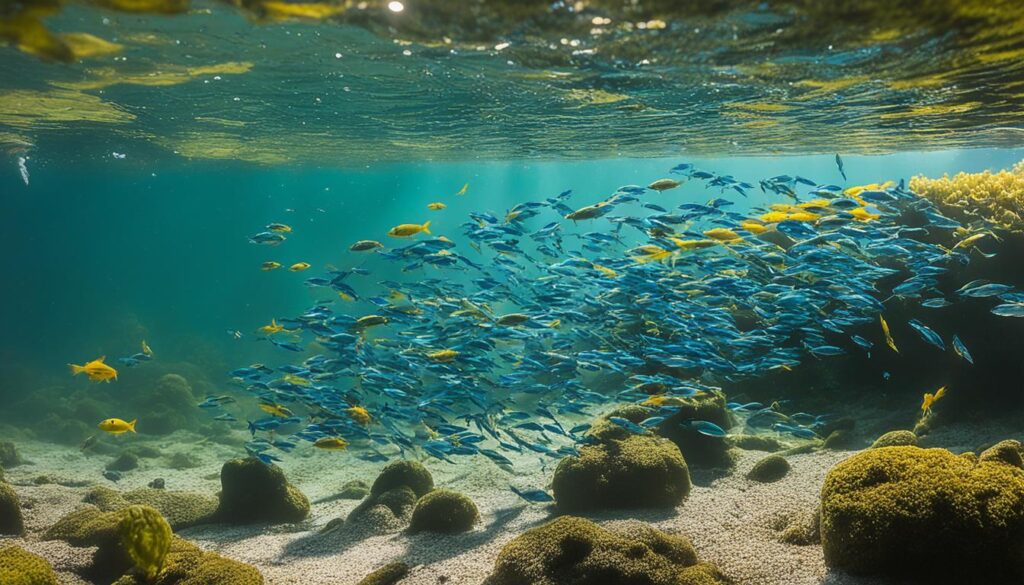
Checking Ammonia and Nitrite Levels
Throughout the cycling process, it is crucial to regularly monitor the ammonia and nitrite levels in your aquarium. By testing these parameters using a reliable aquarium test kit, you can ensure the health and well-being of your fish.
Ammonia Levels: It is important to maintain ammonia levels within the appropriate range, typically around 3 parts per million (ppm). This provides a food source for the nitrifying bacteria responsible for converting ammonia to nitrite. Regularly monitoring and maintaining ammonia levels will support the growth and establishment of beneficial bacteria in your tank.
Tip: Remember to follow the instructions provided with your aquarium test kit for accurate testing and interpretation of results.
Nitrite Levels: As the nitrifying bacteria convert ammonia to nitrite, the nitrite levels in the aquarium will begin to rise. This rise in nitrite levels indicates that the bacteria are actively converting ammonia and progressing through the nitrogen cycle. However, high nitrite levels can be harmful to fish, so it is crucial to monitor them closely.
Quote: “Regular testing of ammonia and nitrite levels is essential for ensuring a successful cycling process and a healthy aquatic environment.”
As the cycle progresses, you may notice a decrease in nitrite levels. This indicates that the beneficial bacteria are establishing a stable population and effectively converting nitrite to nitrate. It is important to continue monitoring both ammonia and nitrite levels until they reach safe levels, ensuring a properly cycled and stable aquarium environment.
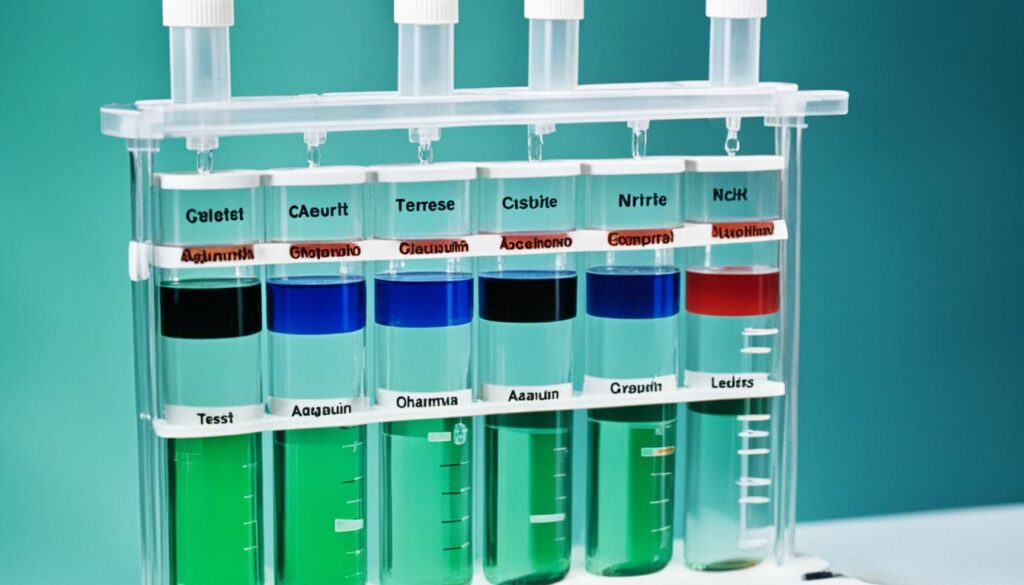
| Parameter | Ideal Range |
|---|---|
| Ammonia Levels | 3 ppm |
| Nitrite Levels | 0 ppm |
Note: It is crucial to regularly test and maintain ammonia and nitrite levels to provide a safe and healthy environment for your fish.
Checking Nitrate Levels and Introducing Fish
As the nitrite levels in your aquarium continue to drop, and the nitrate levels increase, it’s a positive indication that the cycling process is nearing completion. Nitrate is a much safer compound for fish compared to ammonia and nitrite. Once nitrate becomes detectable, it means that your tank is ready for the exciting step of introducing fish.
To ensure that the beneficial bacteria in your aquarium have enough food to thrive, continue adding half the amount of fish food you initially used, approximately once every two to three days. This will provide a steady source of ammonia for the nitrifying bacteria to convert into nitrate.
It’s crucial to monitor the levels of ammonia, nitrite, and nitrate regularly using an aquarium test kit. By doing so, you can maintain optimal water quality and safeguard the health and well-being of your fish.
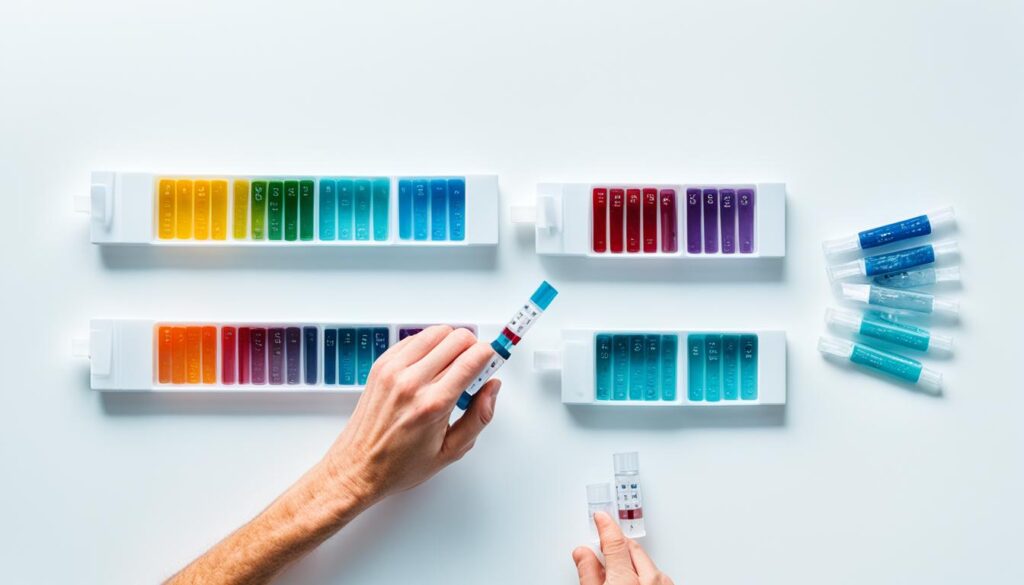
“Regularly monitoring ammonia, nitrite, and nitrate levels using an aquarium test kit is essential for maintaining a healthy and stable environment for your fish.”
Conclusion
Cycling a large freshwater aquarium efficiently is essential for creating a healthy and thriving environment for your fish. By following the 10 steps outlined in this guide, you can successfully cycle your aquarium and ensure optimal water parameters for your aquatic pets.
Regularly monitoring ammonia and nitrite levels is crucial during the cycling process. Maintaining proper filtration, such as using bio filters, helps establish beneficial bacteria that break down fish waste and maintain water quality. This bio filtration process is vital for the overall health and well-being of your fish.
When introducing fish to your aquarium, it’s important to do so gradually. This allows the beneficial bacteria to establish a stable population and ensures that the tank is ready to accommodate the fish. By following these steps, you can create a safe and comfortable environment for your fish to thrive in.
Remember, maintaining a healthy cycling process and monitoring water parameters regularly are key to ensuring the longevity and well-being of your fish. By cycling your aquarium efficiently, you are laying the foundation for a beautiful and sustainable aquatic habitat.
FAQ
What is aquarium cycling?
Aquarium cycling is the process of creating a biologically safe environment for fish in a new tank. It involves introducing nitrifying bacteria to regulate the nitrogen cycle and prevent ammonia buildup from fish waste. The bacteria convert ammonia to nitrite, and then nitrite to nitrate, completing the nitrogen cycle. This process is essential for the health and longevity of your fish.
Why do aquariums need to be cycled?
Aquariums need to be cycled to allow nitrifying bacteria to establish themselves in the biofilters. This is important because these bacteria help break down the ammonia produced by fish waste. If fish are introduced too quickly or in large numbers, the biofilters may not be able to keep up with the ammonia levels, leading to New Tank Syndrome. Cycling the aquarium ensures that the tank is biologically prepared for the introduction of fish, reducing the risk of ammonia exposure and promoting fish health.
How long does an aquarium take to cycle?
The time it takes for an aquarium to cycle can vary depending on factors such as tank size, water pH, and water temperature. Generally, aquariums take between four to eight weeks to complete the cycling process. To expedite the process, it’s essential to closely monitor the water temperature and pH, ensuring they remain within the appropriate range. Testing ammonia, nitrite, and nitrate levels every one to two days will help track the progress of the cycle. The cycle is considered complete when ammonia and nitrite levels reach zero and nitrates are being produced.
What do I need to cycle an aquarium?
Before cycling an aquarium, you will need fish food to provide a source of ammonia, an aquarium test kit to monitor ammonia, nitrite, and nitrate levels, and all the necessary aquarium components such as pumps, filters, and substrate. It is also important to have a quality water filter, preferably one that uses reverse osmosis water, to eliminate contaminants such as chlorine and chloramine that can interfere with the nitrogen cycle.
How do I cycle an aquarium without fish?
Cycling an aquarium without fish is a popular and humane method that involves setting up the tank’s components, maintaining the water pH within the appropriate range, adding an ammonia source, monitoring ammonia, nitrite, and nitrate levels, and adding fish once the cycle is complete. This method allows for a more controlled and safe environment for the fish, reducing the risk of ammonia exposure during the cycling process.
How do I set up the tank’s components?
Before cycling the aquarium, it is important to ensure that all the necessary components, such as pumps, filters, and substrate, are properly set up and functioning. These components provide surfaces for nitrifying bacteria to accumulate and reproduce, helping establish biofilters that facilitate the nitrogen cycle. Keeping all bubblers, heaters, pumps, and filters running during the cycling process is crucial for the growth of beneficial bacteria.
How do I check the water’s pH?
Maintaining the water’s pH within the appropriate range is important for the nitrogen cycle and ammonia regulation. A pH level between 7.0 and 7.8 is ideal for the nitrogen cycle to occur efficiently and for the health of most freshwater fish. Water that is too acidic or too alkaline can disrupt the nitrogen cycle and lead to ammonia buildup. It is recommended to test the water’s pH regularly using pH test strips or an all-in-one test kit.
How do I add ammonia to the tank?
To kickstart the nitrogen cycle, an ammonia source needs to be added to the tank. One effective method is to add fish food, allowing it to decay and release ammonia into the water. The amount of fish food added should be equivalent to what would be fed to the desired number of fish in the tank. Regularly check and maintain ammonia levels within the appropriate range, usually around 3 parts per million (ppm), using an aquarium test kit.
How do I check ammonia and nitrite levels?
Throughout the cycling process, it is important to regularly check ammonia and nitrite levels using an aquarium test kit. Ammonia levels should be maintained within the appropriate range, usually around 3 ppm, to provide a food source for the nitrifying bacteria. Nitrite levels will begin to rise, indicating that the bacteria are converting ammonia to nitrite. Once nitrite levels begin to drop while maintaining adequate ammonia levels, it indicates that the bacteria are establishing a stable population and the cycle is progressing.
How do I check nitrate levels and introduce fish?
As nitrite levels continue to drop and nitrate levels increase, it indicates that the cycle is nearing completion. Nitrate is a safer compound for fish, and once it reaches detectable levels, the tank is ready for fish introduction. To ensure the bacteria have enough food, continue adding half the amount of fish food from the first day about once every two to three days. Monitor ammonia, nitrite, and nitrate levels regularly using an aquarium test kit to maintain optimal water quality and ensure the health of the fish.
